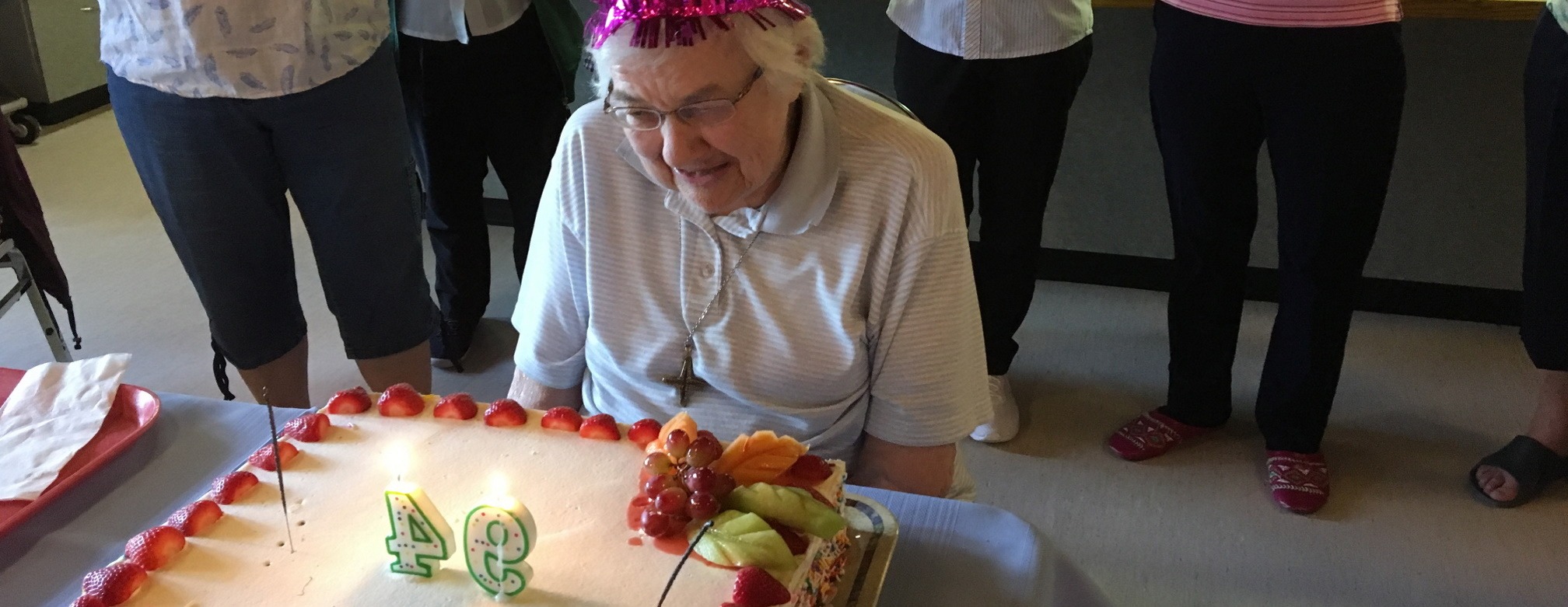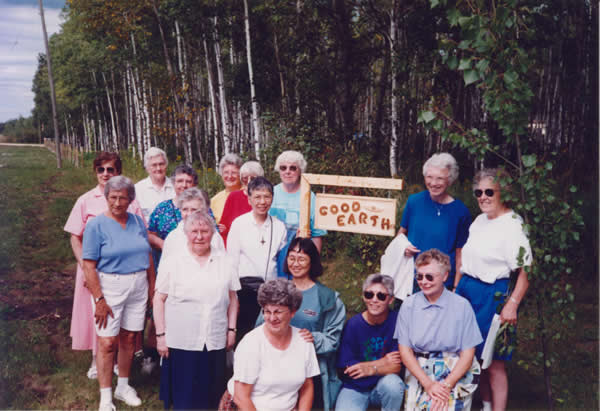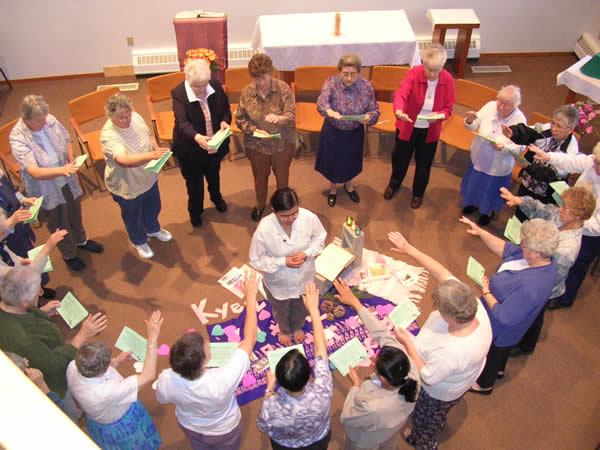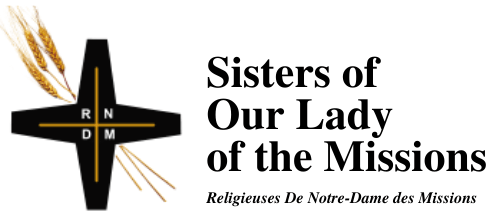
Contents
- Good Earth – St. Anne, MB
- Gurtishall – Place of Peace
- Ministry at Blue Mantle Thrift Shop – Regina, SK
- Spiritual Direction
- Work with Development and Peace / Développement et Paix (D&P)
- The Summons – The New Adult Faith Formation Programme
- Learning from Earth
- Parish Ministry
- My Work in Parish Ministry
- Centering Prayer
- Work with Refugees
- Ministry as a Canon Lawyer
- 12-Step Work
- Counselling
- Work With Persons with AIDS
- Work For and With Women
- Women’s Equality in the Catholic Church
- Work with Gay, Lesbian, Bisexual and Transgender Persons
- University Faculty
- Facilitation
- Alternate Health
Good Earth - St. Anne, MB
The inspiration for Good Earth rose in some Sisters, out of a farming background and many years of living with First Nations people in a remote part of Manitoba.
There was a strong desire to honour the Good Earth, to live lightly on her; to foster care of her and of all the non-human inhabitants living on this small part of her and to grow in appreciation of her ourselves and let this happen to anyone else that came in contact with her though us.
The property purchased in December of 1996 was a little over five acres.

About one acre was developed into house, garage, lawns and garden. The rest was bush.
There was a remarkable variety of vegetation: Poplar, scrub oak, ash and maple as well as some evergreens, which had been planted. There were willows, high bush cranberries, saskatoon and chokecherry bushes as well as innumerable grasses and shrubs. New discoveries of roses, tiger lilies and clumps of lady slippers showed up every spring.
This abundance of vegetation made a great home for many species of animals, birds and all it takes to make up a living community. We tried to encourage and to appreciate it all.
In the winter of 1998 the Community had a meeting to explore sustainable and affordable housing and the possibility of straw bale construction was brought up. The idea was to show that if you had a piece of land and you were willing to put in the sweat equity, you could have a home that was environmentally friendly for a very reasonable price. Since we owned the property at Good Earth, it was decided that we would build a small building to demonstrate this: and so the Straw Bale Building was begun in the spring of 1999.
It took much preparation and the help of Stephen Wiebe to prepare the ground before the first crew of Sisters and friends poured the concrete for the foundation. Other “bees” were held for the raising of the walls and for the plastering. Stephen continued to oversee the project and several of the sisters devoted many of their weekends to it. It was the second summer before the interior walls were plastered and the building was complete. On September 11, 2001 the solar panel was put in place. A 16’x16’ straw bale building with a steel roof, solar lights and wood heat was constructed for $8,000. It could be done!
The project served much more than the raising of a building. There was a great sense of Community engendered by the project and Stephen has gone on from this, his first project, to being involved in the building of many straw bale homes throughout the country.
As the Sisters living at Good Earth needed more medical attention it was decided to sell the property in 2008. Hopefully some of the lessons learned continue to bear fruit.
-June Lenzen rndm
Gurtishall – Place of Peace
Gurtishall – Place of Peace, an integral part of Wiens Family Shared Farm, was established in 2001 in collaboration with Wilma and Dan Wiens and family, as a place of integration of spirituality and care of the earth. It was named as a Place of Peace during its “organic blessing” on 11/11 as a counter witness to 09/11. Gurtishall is Gaelic for Place of Peace.
With an intuitive belief in the wisdom of earth, founding members (Wilma, Dan and Sheila), committed themselves to deep listening to the earth’s rhythms and gifts and to responding to all earth desires to teach us.
During the ten years of our partnership, we have been able to establish significant connections with the earth and with other ‘earthlings’. To name the most obvious, as immediate neighbours, four households have built community by sharing a pot-luck supper each month and an expanding experience of Christmas each December. West Broadway Good Food Club and West Broadway Veggie Wagon are the result of collaboration between Wiens Family Shared Farm and some of the West Broadway people. Each month women from the First Nation have gathered here to offer prayer and to share their sacred stories in a Moon Ceremony. Two Food Justice Workshops have been offered at the farm and during each summer, numerous young persons have been able to explore all that is organic. Participation in the 100-mile diet and in petrol-free Fridays have been part of our life. The marking of a 70th birthday, a marriage ritual and celebration, the 25th anniversary of marriage commitment and the 50th anniversary of religious vows, as well as ordinary campfires, have been part of the rhythms of this special land – this holy ground.
A labyrinth and a hermitage now grace the land. Centering prayer sessions and days of prayer focused on the unfolding story of the Universe and the gifts of nature have been part of our shared life. Dogs and cats, sheep, goats, chickens, ducks, guinea hens and “Honker” (a stately goose), bees, birds and butterflies as well as much wild life fill out the roll-call of our Earth Community at 1395 Lasko Road – 11 kms south of the Perimeter on Highway 200 (St. Mary’s Road).
-Sheila Madden, rndm and Marie Finn, rndm
Ministry at Blue Mantle Thrift Shop – Regina SK
The Blue Mantle is a Catholic Charitable business that ministers to the community by gathering, selling and giving clothing, furniture and household items in a spirit of service, welcome, respect, compassion and hope.
Just a few days before the re-opening of the renovated Blue Mantle in 2004, I met Katherine Duke, the Director, and asked her if she needed a helper. As a retired teacher, I recognized this as a way for me to further express my care and concerns for those marginalized in Canada, so when she said “yes!”, I took on working with her. It was originally my intention to help her for a few days. But God had other plans for me, and so I stayed for six years.
From the beginning I served on the board of directors with dedicated men and women who, like me, were deeply concerned with the plight of the poor. My mission was reaching out to the needy, the single mothers, the elderly, immigrants and their families, comforting the grieving, praying with the troubled ones etc. Students often came to put in a few hours of work so as to receive credit for their Christian Ethics Classes. Students, jobless people, especially immigrants with language barriers, came looking for work and were often hired to do the many chores required in such a setting.
My priorities were the people but during my in-between time I packed boxes for needy families, I also unpacked the many boxes brought in by the generous donors who gave clothing, household items, books, furniture, antiques etc. that would be priced and sold. Many a time varied merchandise was freely given to the very needy or sold at an extremely low price.
After six years, I knew that it was time for me to leave with the conviction that I had the privilege of helping to fulfill Blue Mantle’s Mission of service to the poor.
-Rose-Aimee Belisle rndm
Spiritual Direction
Some of our Sisters are spiritual directors. They describe something of their ministry below:
The practice of spiritual direction invites a person to pay attention to his/her longing for wholeness, for the Sacred, for meaning in life. This practice is grounded in a relationship of trust and respect where one is taken seriously in one’s yearning for life to the full. On the part of the director it involves prayerful and reflective attentiveness to the whole person, that is, physically, emotionally, mentally and spiritually.
A safe space is created where we are able to explore who we most deeply are—that fundamental core of goodness whose centre is the Divine spark in all of us. Attention is paid to the breadth of experiences that make up our entire lives. Prayer and reflection are an integral part of the process. We come to realize and appreciate God-with-us in every dimension of our lives. Likewise we realize more fully how creation is also permeated with this Sacred Mystery.
-Christina Cathro rndm
The ministry of spiritual direction is a gift of the Spirit offered to people who seek a deeper, more conscious relationship with the Divine. Through the skills of active listening and posing evocative questions a director can help to facilitate a seeker’s longing for greater intimacy with God, themselves, others and all creation. It is said that “God comes to us disguised as our life,” (Paula D’Arcy) so, indeed, all aspects of one’s life experience is fertile soil for God’s communication to the soul: in tilling the garden of our longing God reveals our inner truth and grows in us a life-giving freedom.
RNDMs throughout the world have longed encouraged the gift of spiritual accompaniment by supporting the extensive training and formation of many of their members for this ministry. In helping to facilitate the development of a seeker’s relationship with God, a spiritual director is most simply a faithful and trusted companion on the journey of faith. The Spirit of God is the one true director!
“Within each of us lies the desire to find meaning beyond the moment… to discover our true selves… to grow closer to God. A spiritual director can help you satisfy that longing.” (Spiritual Directors International)
-Sandra Stewart rndm
Work with Development and Peace / Développement et Paix (D&P)
RNDMs have long-time commitments to issues of justice, peace and the integrity of creation and for many this expresses itself through the Canadian Catholic Organization for Development and Peace (CCODP). Development and Peace was founded in 1967, by the Canadian Bishops of Canada, and is the official arm of International Solidarity for the Canadian Catholic Church.
Here is an account from one Sister currently involved with D&P:

“After my experiences as a teacher and a missionary in Peru, since 2006 I have been a member of the “Conseil diocesain francophone de Developpement et Paix ” of the St-Boniface Diocese. We meet once a month. Once a year, the Provincial Reunion takes place for all the members of Development & Peace of Manitoba. (St-Boniface francophone, St-Boniface anglophone, Winnipeg, Le Pas). The goal of this annual meeting is information, re-committment, and voting on various propositions to further assist our partners in the global south:
A) By financially supporting their projects.
B) In bringing awareness to Canadians of the causes of their poverty, and mobilizing actions on their behalf.
Each autumn, there is an education campaign of the Canadian public. Material is sent from the National offices in Montreal to each parish and contact person. A “Share Lent” collection is organised in all the churches of the country as a way for Canadians to enter into the season of Lent.”
-Diane Belisle rndm
The Summons – The New Adult Faith Formation Programme
“The Summons” is a two year, adult faith formation program begun by the Archdiocese of Winnipeg in 2009. Adult education processes are engaged so that we learn together from our sharing of life experiences. Components of this formation programme include learning and reflection on scripture, spirituality, theology, human growth, liturgy and the ministry of presence.
My part in this programme is the exploration of human growth. I like to approach dimensions of our human growth through the lens of spirituality. All growth is a spiritual event. We live in a graced world where the Divine is present. Always, my starting point is affirmation of the fundamental goodness of human nature as an essential element of Christian faith; this central heart of goodness is capable of unlimited growth.
I so enjoy exploring areas of human growth with the participants. Some of these areas of exploration include discernment in decision-making, mid-life invitations to growth, focusing as a tool for listening to the body and accessing our feelings, the enneagram as a tool for self-understanding, facilitating circles of trust where we move toward creating courageous conversations with one another, and shadow work and projections. My dream would be for every adult in our faith communities to participate in this faith formation program.
-Christina Cathro rndm
Learning from Earth
A key feature of RNDM life over the past many years has been a growing integration in learning from the wisdom of earth and all creation. Wendy MacLean, a significant partner with us in this enterprise, is committed to applying the wisdom of organic and sustainable gardening to her own efforts as a gardener. She is learning to work with the characteristics of the land she gardens—its soil, climate, flora and fauna—and garden in a way that learns from and enhances the life of other living beings with whom she shares the space. To this end, she follows these and other practices: growing a rich diversity of plants to meet the needs of a rich diversity of other creatures; growing pollen-and nectar-rich plants as food sources for butterflies, bees and birds; planting shrubs and trees to provide food and habitat; choosing native species of trees, shrubs and other plants as often as possible; reducing waste, enriching the soil and honouring the cycle of life by composting plant material and appropriate kitchen scraps and adding the completed compost to the soil; mulching the soil to conserve moisture, reduce weeds and protect plants from extreme heat and cold; using nitrogen fixing plants like peas and beans to enrich the soil; growing heirloom varieties of vegetables and annual flowers, and saving seeds for future crops; collecting rainwater and using it as much as possible for watering garden plants.
Currently, she is beginning to explore the field of Permaculture (Permanent Sustainable Culture or Permanent Sustainable Agriculture) and hopes to integrate its wisdom into her gardening practices.
The three main ethics that guide Permaculture are:
- Care of the Earth – designing a landscape that has a low environmental impact, is sustainable and provides for all life systems to continue and multiply
- Care of the People – encouraging people to embrace sustainable ways of producing abundant food needed for their continued existence
- Care of the Community – sharing surpluses, whether these be ideas, skills, food and/or goods
Some gardening practices associated with Permaculture are: organic soil management (composting, mulching, etc.); natural pest management (encouraging natural controls such as birds, predator insects); use of native species, heirloom vegetables and perennials; guilds/companion planting; seed-saving; and efficient use of water.
-Wendy MacLean
Parish Ministry
Some aspects of parish ministry that is carried on in parishes today by RNDMs is : Secretarial work for a parish, Sacramental Preparation for children and adults, Singing in church choirs, Scriptural Reflections on the upcoming readings, Preparing and leading Liturgical Celebrations, Ministry to the dying and their loved ones, Celebrating Prayer services for the Dead, Leading Funerals, Ministry to young parents, Visiting homes, Parish Presence in the Catholic schools, Helping teachers prepare for School Celebrations, Leading Children’s choirs, Facilitating Retreats for Parishioners,

Leading Different types of Prayer, Being a member of the Catholic Women’s League, Leading bus groups to Spiritual Sites, Being a member of the Pastoral Council in a Parish, Bringing a bigger picture of “church” to a parish, Deepening and broadening the parishioners understanding of living their faith, Being a Hospitable presence.
-Anna Aulie rndm
My Work in Parish Ministry
For a Nun, a feminist, a hard worker, a Church-loving person the most fulfilling Ministry in our post Vatican time is certainly that of a parish minister. Mandated by the Bishop, one becomes, for a time, a co-worker among the Roman Catholic Clergy and soon learns to appreciate and value these devoted men, our friends and our brothers in Christ who faithfully give their lives in prayerful service and fidelity to their calling.
The Administrative duties of a parish minister soon became a routine reality, but the most challenging responsibility was that of reaching out to all who formed our parochial Christian Community. One had to grasp the challenging the needs, aspirations, the very desire for communal involvement so as to ever develop one’s spiritual life and answer the call of the Gospel. As parish Minister, I had to become One to All, and, One with All. We helped each other broaden our horizons of Service, of personal growth in Spirituality, and of consciousness of our World and of our Universe. The word delegate became extremely important. In fact it was the motivating Force of our actions. Our Communal Hospitality welcomed all who crossed the threshold of the parish church. Everyday we challenged ourselves to see Christ in the needy, the poor, the addict, the lonely, the sick, the politician, the bereaved, our fellow priests and Bishop, and the many who stopped to visit, to chat, to shed a tear, to drop a few dollars into the emergency fund for the needy. Our Hospitality was our “raison d’être.” It was the backbone of our liturgical celebrations and gatherings; be they our weekly Mass or Lay-Services, our Sacraments and their preparations, our every brunch, coffee sharing, card games or autumn banquets. After five and a half years as Parish Minister, my farewell words were: “Je n’ai jamais travaillé si fort mais je n’ai jamais été si heureuse!“
-Cecile Campeau rndm
Centering Prayer
Centering prayer is a relationship with God and a discipline to foster that relationship. It is a movement beyond conversation with Christ to communion with Christ. Therefore it is a form of prayer beyond words, thoughts and images. Centering Prayer is not meant to replace other kinds of prayer. It tends rather to bring greater light and depth of meaning on them. Centering Prayer prepares us to receive the gift of Contemplation.
Centering Prayer is a method that is based on the teaching of earlier times in the Church. The source of Centering Prayer, as in all methods leading to Contemplative Prayer, is the indwelling Trinity. The focus of Centering Prayer is the deepening of our relationship with the living Christ. It tends to build Communities of faith and bond the members together in mutual friendship and love.
-Claire Himbeault rndm
Work with Refugees
For many years the Sisters of Our Lady of the Missions in Saskatchewan and Manitoba have been involved with sponsoring and supporting those who come to Canada as refugees.
One particular aspect of this ministry in which the Sisters have been principally involved is through the establishment of “Hospitality House” – a place where these men, women and children could live temporarily as they oriented themselves to their new life in Canada.
Hospitality House belongs to the Anglican Diocese of Rupert’s Land and was set aside for refugee ministry. We acquired it for our ministry, and as soon as the carpets were laid we moved in on 2 September 1992. We had been sponsoring refugees for at least five years and it had become very apparent that we needed a settlement house to accommodate new arrivals as we assisted them in their task of integrating into Canadian society. Our first occupant was a young girl from Somalia. She was a deaf mute who had lived in Italy and we wrote notes to each other in our limited Itallian. We were able to accommodate about ten people at a time. Our contract calls for support during their first year in Canada or until they became independent. The majority are sponsored at the request of family or friends already in Winnipeg, who assist in the resettlement work.
Because of a fire on 13 August 1999 the whole house was gutted and remodelled. Sister Margaret Purdie had just arrived to assist in the work – she was given a warm welcome. A decision was made to give the ministry a more permanent structure. The Advisory Board became a Board of Directors and the ministry was registered with the Federal Government as an Independent entity with charitable status. This was done just before Aileen Gleason left in August 2002. The Archdiocese of Winnipeg invited Hospitality House to move its offices (which had been accommodated in the director’s bedroom) to their Development and Peace offices at Micah House. Margaret made that move. Shortly after she returned to New Zealand and one of the Board members, Tom Denton, took over the direction of the work. Hospitality House Refugee Ministry Inc. probably sponsors the most refugees of any private sponsorship group in Canada. Its website is: www.hhrmwpg.org
-Aileen Gleason rndm
Ministry as a Canon Lawyer
The law of the Church, ‘Canon Law’, covers many areas of discipline and practice in the church. As a canon lawyer, I am the director of the Marriage Tribunal and Vice-Chancellor for the Archdiocese of Winnipeg. The church has laws governing marriages and in the tribunal I work with a team of other canon lawyers to assess whether or not these requirements of law were fulfilled. This is often referred to as an ‘annulment’, but the preferred term is ‘declaration of nullity’ because we are simply declaring that some requirement of law was missing so the marriage is null. As Vice-Chancellor, I assist in dealing with other areas of church law, and serve on a committee dealing with sexual abuse. I also advise in the field of Religious Law, providing canonical expertise and assistance to members of religious communities in Manitoba, across Canada, and in the Congregation of the Sisters of Our Lady of the Missions. .
Canon Law itself is very clear that the purpose of the Church’s law is the good of the People of God and not a fixed set of uniform laws to be woodenly applied. Canon lawyers are mandated always to blend a deep pastoral sense to the application of law. The work is both challenging and pastorally fulfilling.
-Betty Iris Bartush rndm
12-Step work
A number of Sisters have been involved in receiving “Fifth Steps”, a key part of the twelve step recovery process of Alcoholics Anonymous. The fifth step is one in which the recovering person admits “to God, to ourselves, and to another human being the exact nature of our wrongs”. (Alcoholics Anonymous,1981 p. 55) Individuals making their Fifth Step turn to a trusted person to listen to their account, and many Sisters have offered this confidential service.
Counselling
Some Sisters are professional Counsellors, and offer this service in a variety of contexts – church settings, community based settings or through private practice.
Work with Persons with AIDS
Some Sisters work with persons who are HIV positive or who have AIDS. One particular venue for this service has been through Kali Shiva, which offers drop-in resource services for people living with HIV and people at risk of contracting it. It also runs programs for HIV+ women.
Work For and With Women
Some Sisters work with women who have been abused in childhood or as adults, either in therapeutic settings or as supportive advocates. One such commitment has been through the founding of TARA’S Vision (Trauma/Abuse Recovery for Adult Survivors) in Ste. Rose du Lac and Dauphin.
Women’s Equality in the Catholic Church
Some Sisters work with women and men for gender justice within the Roman Catholic church. A group in which many of the Sisters are involved is the Catholic Network for Women’s Equality (CNWE). CNWE was begun in 1981 as an advocacy group for women’s ordination, and the women and men of CNWE work for the renewal of ecclesial structures, and for the full participation of women in all aspects of the daily life and structure of the Roman Catholic church. CNWE members seek to live out together their baptismal vocation as a discipleship community of equals. They contribute to opening up spaces in which new paradigms for women’s faith praxis and well-being can flourish.
Work with Gay, Lesbian, Bisexual and Transgender Persons
Some Sisters work with LGBT+ persons and groups. One such group is Dignity Canada Dignité. Dignity is a Catholic group whose members who are concerned about the Catholic sexual theology, particularly as it pertains to gay, lesbian, bisexual, and transgender persons. They work in collaboration with other Catholic organizations seeking reform in church leadership and teachings.
University Faculty
Three Sisters are University faculty at Universities – one in the music department at Brandon University and the others at the theological college of St. Stephen’s at the University of Alberta.
Facilitation
The facilitation provided by the Sisters is grounded in Adult Learning Theory (eg. David Kolb) and Transformational Learning (eg. Jack Mezirow).
The principles of adult learning have important applications when designing events. In other words, tasks for adult learners need to be experientially based, that is, centered on adults’ experience, knowledge and judgment.
Transformational learning theory as developed by Mezirow also draws on the learner’s experience as raw material. Experience, critically reflected on is the starting place for transformational learning.
Environment is key to transformative learning. Participants need to have all available and appropriate information, be free from coercion, and have equal opportunity to assume different roles. In such a climate learners are more likely to be critically reflective of assumptions, be empathetic and good listeners, and therefore willing to search for common ground.
A trusting and caring relationship among the participants and facilitator are important for such an environment.
-Denise Kuyp rndm
Alternate Health
Some Sisters are involved in offering and/or teaching alternate health modalities like Reflexology and Reiki. The Reflexology Association of Canada defines reflexology as:
“A natural healing art based on the principle that there are reflexes in the feet, hands and ears and their referral areas within zone related areas, which correspond to every part, gland and organ of the body. Through application of pressure… reflexology relieves tension, improves circulation and helps promote the natural function of the related areas of the body.”
Sisters of Our Lady of the Missions
393 Gaboury Place
Winnipeg, MB
Canada
R2H 0L5
Phone: (204) 786-6051
Fax: (204) 691-0640
